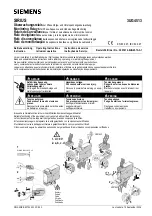
L8148A,E,J AQUASTAT® RELAYS
5
60-2278—9
8.
Fit the case onto the well so the clamp on the case
slides over the flange on the well. Tighten the clamp
screw securely.
IMPORTANT
Best thermal response is obtained with a well that
snugly fits the sensing bulb. For wells used, the bulb
should be inserted until it rests against the bottom of
the well. Use a well of correct length and bend the
tubing, if necessary, to hold the bulb against the
bottom of well, but do not make a sharp bend in the
tubing.
If the well does not fit snugly on the bulb, use the heat-
conductive compound (furnished with TRADELINE® models)
as follows: Fold the plastic bag of compound lengthwise and
twist it gently. Then snip off the end of the bag and work the
open end of the bag all the way into the well. Slowly pull out
the bag while squeezing it firmly to distribute the compound
evenly in the well. Insert the bulb all the way to the bottom of
the well. Bend the tubing, if necessary, to hold the bulb
against the bottom of the well and to hold the outer end of the
bulb firmly in contact with the side of the well (Fig. 4). Wipe
excess compound off the outer end of the well.
Mounting (TRADELINE® Models)
If the old well is suitable, use it and an immersion well adapter
(see Accessories) for the installation; otherwise, refer to the
standard mounting procedure. (Well assemblies for the
TRADELINE® Aquastat® Relays must be ordered separately;
refer to form 68-0040, Wells and Fittings for Temperature
Controllers.) The adapter has a flange at the wide end that fits
into the well clamp and is slotted lengthwise to accommodate
both the capillary tube and the short length of tube extending
from the bulb (Fig. 4).
1.
Turn off all power and remove the old control. Tag each
external leadwire using the cover insert from the old
control.
2.
Loosen but do not remove the well clamp screw on the
side of the control case.
3.
Pull out the capillary tube until it bottoms in the well.
Place the adapter around the capillary tube so it fits into
the slot. Center the loop of excess capillary tubing in
front of the immersion well so it cannot touch any
electrical parts.
NOTE: Some models have a tubing length adjustable to 3 in.
(76 mm). In these models, extra tubing inside the
case can be pulled out, if needed.
4.
Make sure the wide end of the adapter fits into the hole
in the case. Position the immersion well clamp snugly
over the flange on the adapter and tighten the clamp
screw.
5.
Insert the sensing bulb into the well as shown in
Fig. 4. (Distribute heat-conductive compound prior to
insertion.)
6.
Securely tighten setscrew (if present on old well)
against adapter.
Wiring
IMPORTANT
Terminals on the L8148 Aquastat¨ Relay are
approved for use with only copper wire. The
terminals allow only wrap-around wiring.
1.
Strip 7/16 in. of insulation
from the wire end.
2.
Wrap the wire at least 3/4 of
the distance around the screw
as shown.
3.
Using a standard, flat-headed
screwdriver, tighten the screw
until the wire is snugly in
contact with the screw and contact plate.
4.
Tighten the screw an additional one-half turn.
NOTE: Do not use a push-type ratchet screwdriver.
Disconnect power supply before making wiring connections to
prevent electrical shock or equipment damage.
All wiring must comply with local electrical codes and
ordinances. Do not exceed limits in the Specifications section
when applying this control.
When wiring a switch equipped with 1/4 in. tab terminal
connector, use 18 to 22 gauge wire with AMP Inc. part no.
2-520129-2 fully insulated flag receptacle connector or
equivalent.
The L8148E,J can power up to two V8043 Zone Valves.
Additional valves, in groups of two or fewer, require an
additional transformer. Follow appropriate wiring diagrams,
see Fig. 5 through 14, when using zone valves or a low limit
controller.
NOTE: On systems requiring a vent damper, the vent
damper can be connected directly to some L8148E
Aquastat® Relay models (Fig. 12) or an S8610
Ignition Module (Fig. 11).
When the vent damper is plugged into the Aquastat¨ Relay, a
fuse in the Aquastat¨ Relay will blow when the thermostat first
closes. Once the fuse is blown, the Aquastat¨ Relay will not
operate unless the vent damper is connected.
When the vent damper is plugged into the Aquastat¨ Relay, a
fuse in the Aquastat¨ Relay will blow when the thermostat first
closes. Once the fuse is blown, the Aquastat¨ Relay will not
operate unless the vent damper is connected.
With the vent damper plugged into the S8610, a fuse in the
ignition module will blow when first powered. Once the fuse is
blown, the ignition module will not operate unless the vent
damper is connected.
M8843






























